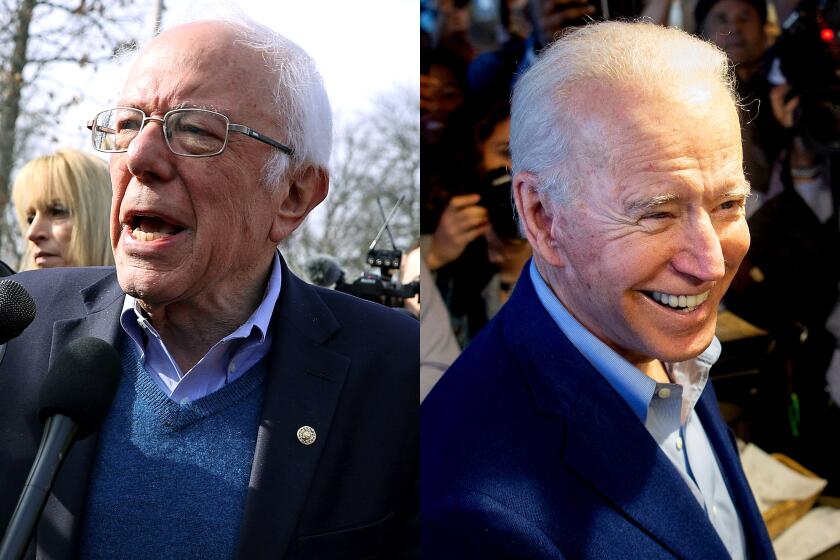Orange County, longtime GOP stronghold, now has more registered Democrats than Republicans

- Share via
Orange County, long a Republican stronghold, has officially turned blue.
The county that nurtured Ronald Reagan’s conservatism and is the resting place of Richard Nixon is now home to 547,458 registered Democrats, compared with 547,369 Republicans, according to statistics released early Wednesday morning by the county Registrar of Voters. The number of voters not aligned with a political party has also surged in recent years, and stands at 440,711, or 27.4% of the county’s voters.
For the record:
12:37 p.m. Aug. 7, 2019An earlier version of this story incorrectly stated the number of Orange County voters registered as having no party preference. The correct number is 440,711.
Democratic leaders attributed the shift to changing demographics, aggressive recruitment efforts and President Trump.

“Trump’s toxic rhetoric and exclusionary policies alienate women, millennials, suburban voters, immigrants and people of color — critical components of the electorate in Orange County,” said Katerina Ioannides, co-chairwoman of the Orange County Young Democrats, one of several groups that worked to increase party registration.
“The Republican Party’s platform no longer resonates in a rapidly diversifying, increasingly college-educated Orange County,” said Ioannides, whose group conducted registration drives aimed at young voters.
Shawn Steel, Republican national committeeman for California, blamed the GOP decline on the large increase in the number of voters who register with no party preference, and on Republicans leaving the state because of high housing costs, poor schools and lackluster job opportunities.
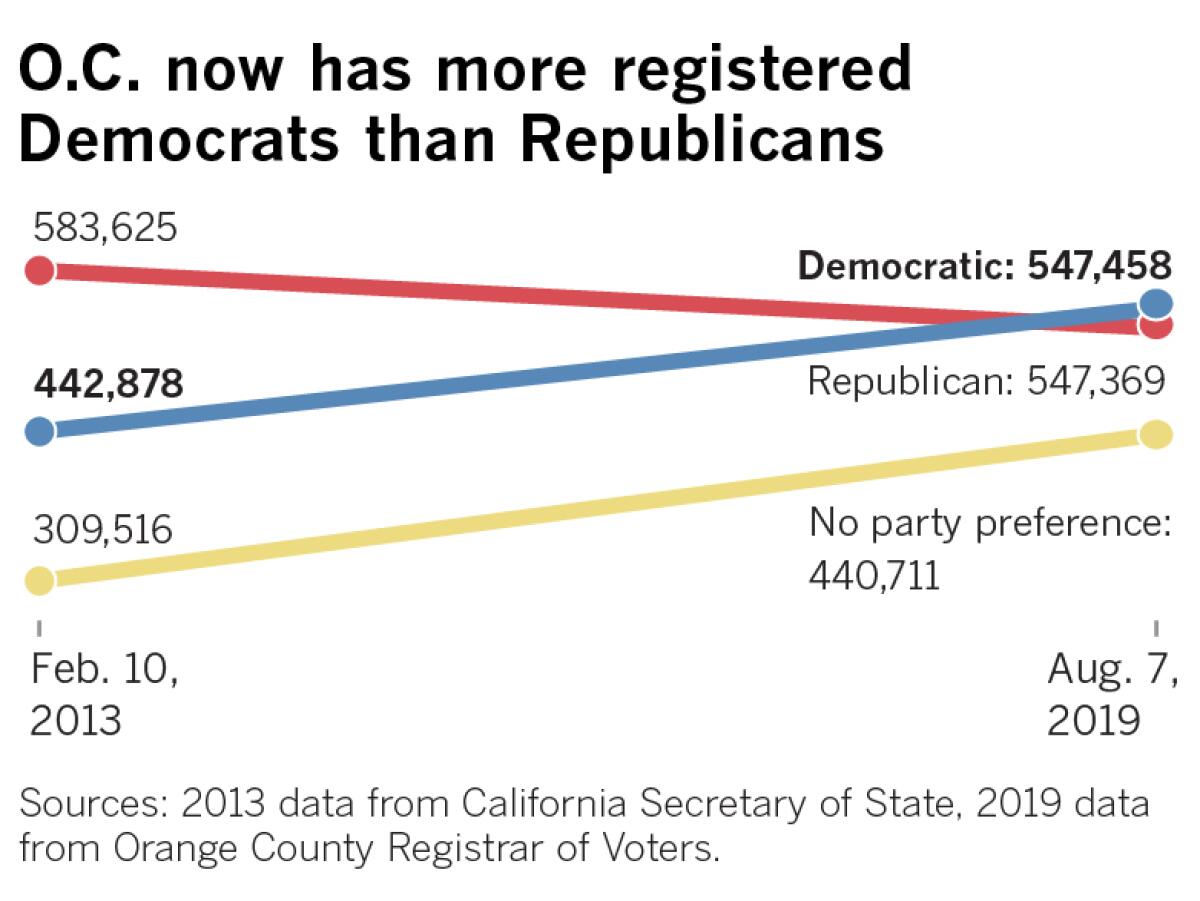
“We’ve been an out-migration state for 20 years, and that’s particularly acute in the suburbs,” said Steel, who predicted that the tide would turn because of overreach by the Democratic politicians who control every arm of state government. “There is an opportunity as Democrats get more aggressive in Sacramento and alienate more people.”
Democrats gaining an edge here over Republicans is a watershed moment for a place that has long been a citadel of GOP strength — and one that could have national implications for the future of the Republican Party.
In La Palma Park Stadium in Anaheim, a month before the Bay of Pigs invasion, 7,500 students and parents skipped school or work and gathered to learn about communist plans to take over the United States.
What’s happened in Orange County is also unfolding in other large, affluent suburbs that Republicans have long counted on to offset Democratic votes in the nation’s large cities, said Stu Rothenberg, veteran political analyst and senior editor at Inside Elections. He described the areas as mainly “upscale suburbs with college-educated voters who have more suburban and cosmopolitan concerns.”
“They see the Republican Party as intolerant old white men,” he said.
Once covered with citrus groves and ranches, Orange County became a suburban haven of tract homes and master-planned communities full of white people fleeing Los Angeles, Midwesterners seeking warmth and workers with ties to the aerospace and defense industries.
The John Birch Society had dozens of chapters in the county, and the phenomenon of megachurches was born here. Orange County was also home to a large community of wealthy Republican businessmen, including Donald Bren of the Irvine Co. and Carl Karcher of Carl’s Jr., as well as famous conservatives such as John Wayne.
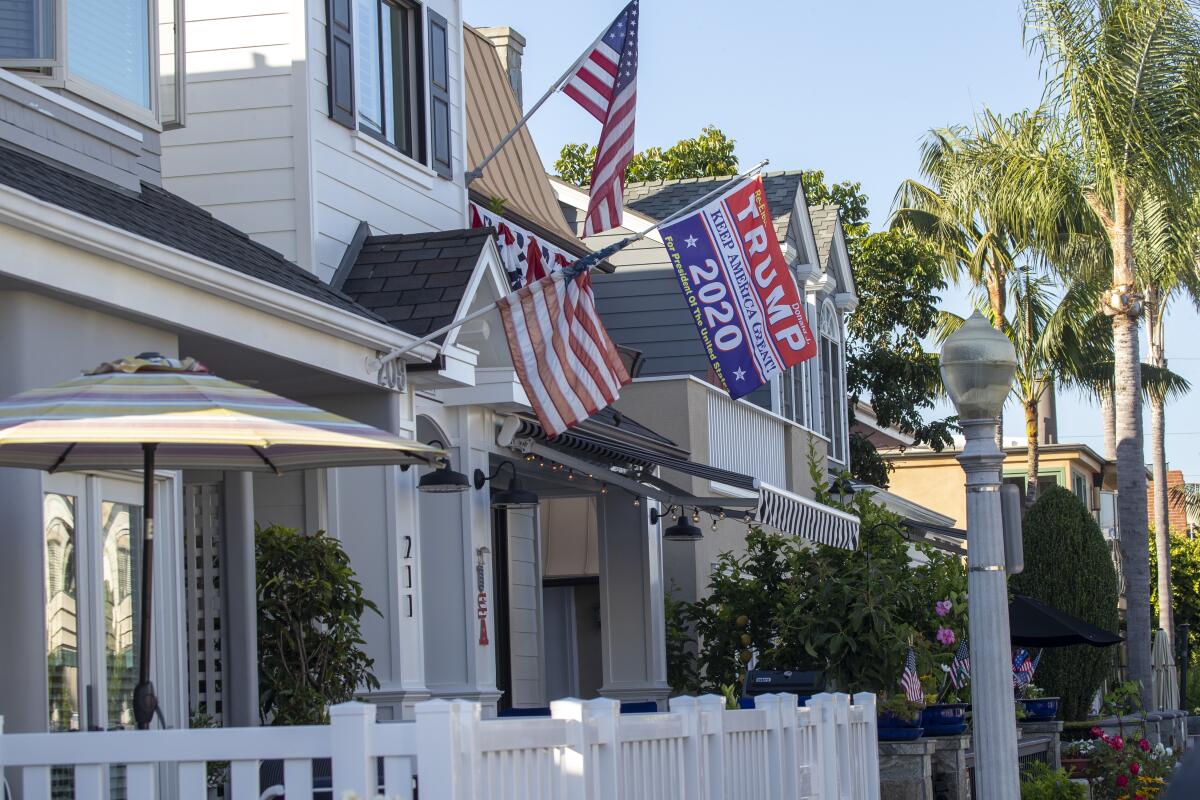
They preached a form of “cowboy capitalism” — free markets, low taxes, deregulation — that made the county a must-stop for GOP candidates from across the nation, said Fred Smoller, a political science professor at Chapman University in Orange.
Reagan’s first political fundraiser took place in Anaheim in 1965 when he was running for governor; in 1984, when he ran for reelection to the White House, he won 75% of the county’s vote.
Former GOP strategist Reed Galen, who registered as a no-political-party preference voter after Trump won the Republican nomination in 2016, recalled relying on the county during campaigns for President George W. Bush, Gov. Arnold Schwarzenegger and presidential candidate Sen. John McCain.
“It was never a question of whether or not you would win Orange County,” he said. “The idea that you could lose it wasn’t even on the books.”
But the county has been trending left in recent years because of changing demographics — growing numbers of college-educated voters as well as minorities and immigrants.
Hillary Clinton beat Donald Trump here by nearly 5 percentage points in the 2016 presidential election, the first time a Democrat won the county since the Great Depression. Franklin D. Roosevelt won Orange County in his 1936 contest against challenger Alf Landon.
In 2018, Democrats flipped four Republican-held congressional seats in the county — wins that were key to the party taking control of the House of Representatives.
Matthew Harper, a former Republican state assemblyman from Huntington Beach who lost his seat to a Democrat by 5 percentage points in 2018, noted that Democrats had success in Orange County in the past.
In the 1970s, in the post-Watergate era, they held a majority of the region’s legislative delegation, including the seat he used to hold.
“It has been a cycle,” Harper said. “It has been a pendulum.”
He said he believed the GOP could rebound in Orange County once the nation’s political environment is less polarized.
“The Republican Party has always been a center-right party, and that’s the natural inclination of Orange County voters,” he said.
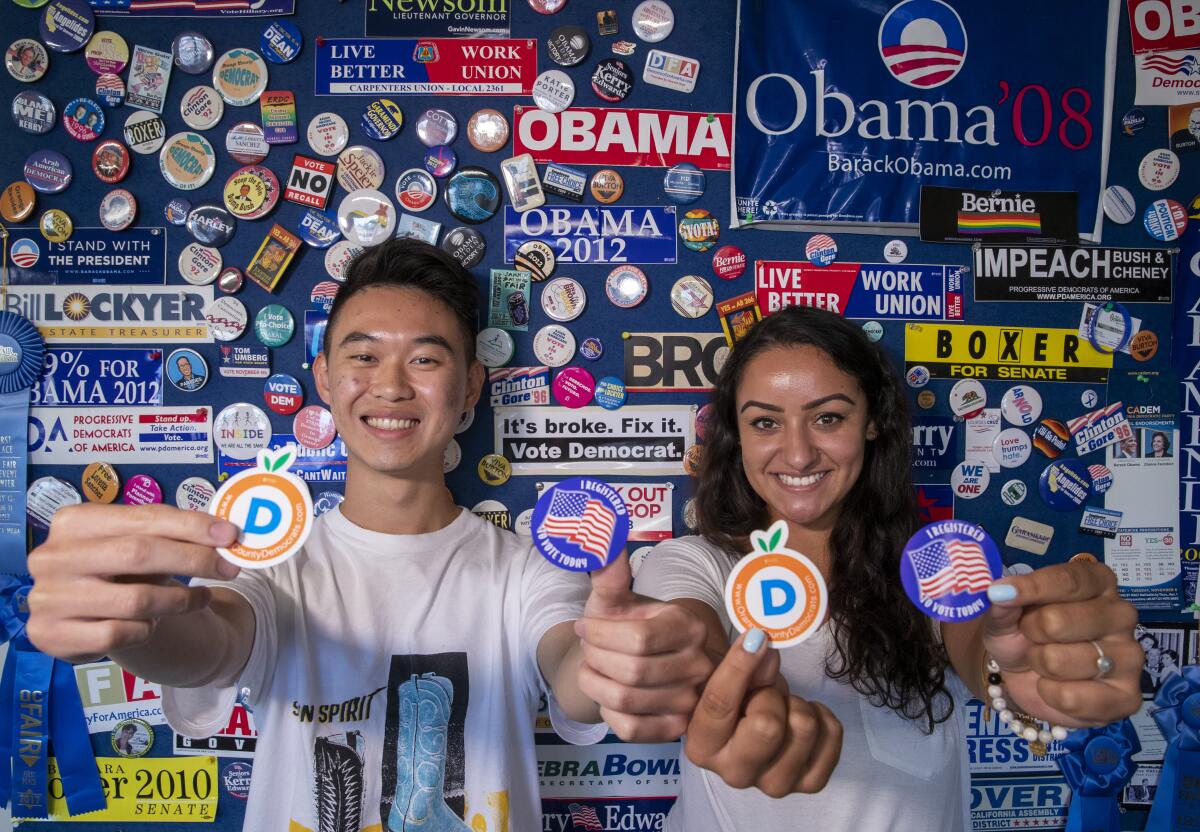
Randall Avila, executive director of the Orange County Republican Party, said many Democratic gains were coming in swaths that are already solidly blue. He also pointed to the surging number of voters who are not affiliated with any political party, a phenomenon seen across the state.
“It just means we need to step up our game; we need to rise to the occasion and competitiveness of the county now,” Avila said, noting that the GOP regularly registers voters at naturalization ceremonies, the DMV, and at events like the Orange County Fair and the Garden Grove Strawberry Festival.
Here are key dates and events on the the 2020 presidential election calendar, including dates of debates, caucuses, primaries and conventions.
The changing voter patterns in Orange County are similar to those that have occurred in places like Montgomery County outside of Philadelphia and Fairfax County in northern Virginia. Such areas historically backed moderate or even conservative Republicans, but in the last 20 to 30 years have trended more Democratic.
Although some of these shifts have been propelled by changing demographics, they are also part of a broader national political realignment.
White working-class, non-college-educated voters are increasingly aligning with Republicans over cultural and social issues, while college-educated voters are increasingly at odds with a national GOP that has grown more hardline on issues such as immigration, according to political experts.
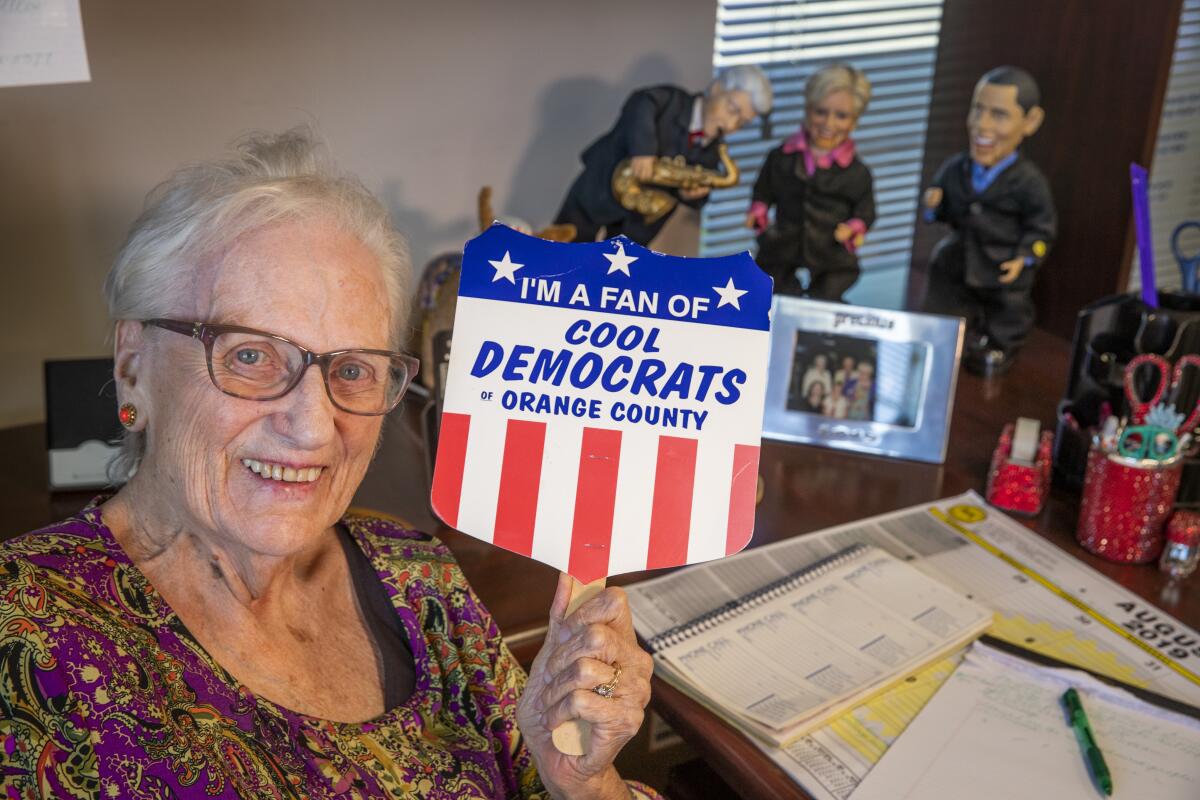
Rothenberg pointed to the Atlanta suburbs, the North Carolina cities of Charlotte and Greensboro, and a number of areas in Texas that could be primed for a political turnaround like that of Orange County.
Even though Democrats have gotten their hopes up in Texas and Georgia before, only to see their expectations fall short, Rothenberg said the tilt leftward in these states may be speeding up.
“We’re starting to get within spitting distance of both of those states re-aligning,” Rothenberg said. “I would’ve dismissed the point eight or 12 or 16 years ago. We’re getting to the point where I can’t dismiss it any more.”
The shift could immediately come into play in several congressional races in 2020, notably in Texas.
Four Republican congressmen in the Lone Star State have signaled they will step down at the end of this term, most recently Rep. Kenny Marchant, who announced on Monday his plan to retire in 2020.
Marchant, who represents the suburban communities between Dallas and Ft. Worth, first won the seat in 2004, beating his Democratic rival by 30 percentage points. In 2018, his margin of victory over his Democratic challenger was just 3 points.
Cal Jillson, a political science professor at Southern Methodist University in Dallas, said Marchant’s district, as well as districts in the Houston suburbs and along the border that are being vacated by sitting Republicans, will probably be very competitive in 2020.
The political shift, Jillson said, was “inevitable — but Trump brought it on more quickly.”
Democrats from Texas, Arizona and Nevada have already been in touch with their compatriots in Orange County to discuss strategy.
“If it can happen in Orange County, it can happen anywhere,” said Ada Briceño, chairwoman of the Orange County Democratic Party. “This is a lesson not to dismiss historically Republican-dominated areas, but to dig in deeper and engage with people, especially those who have never been engaged in our political process.”
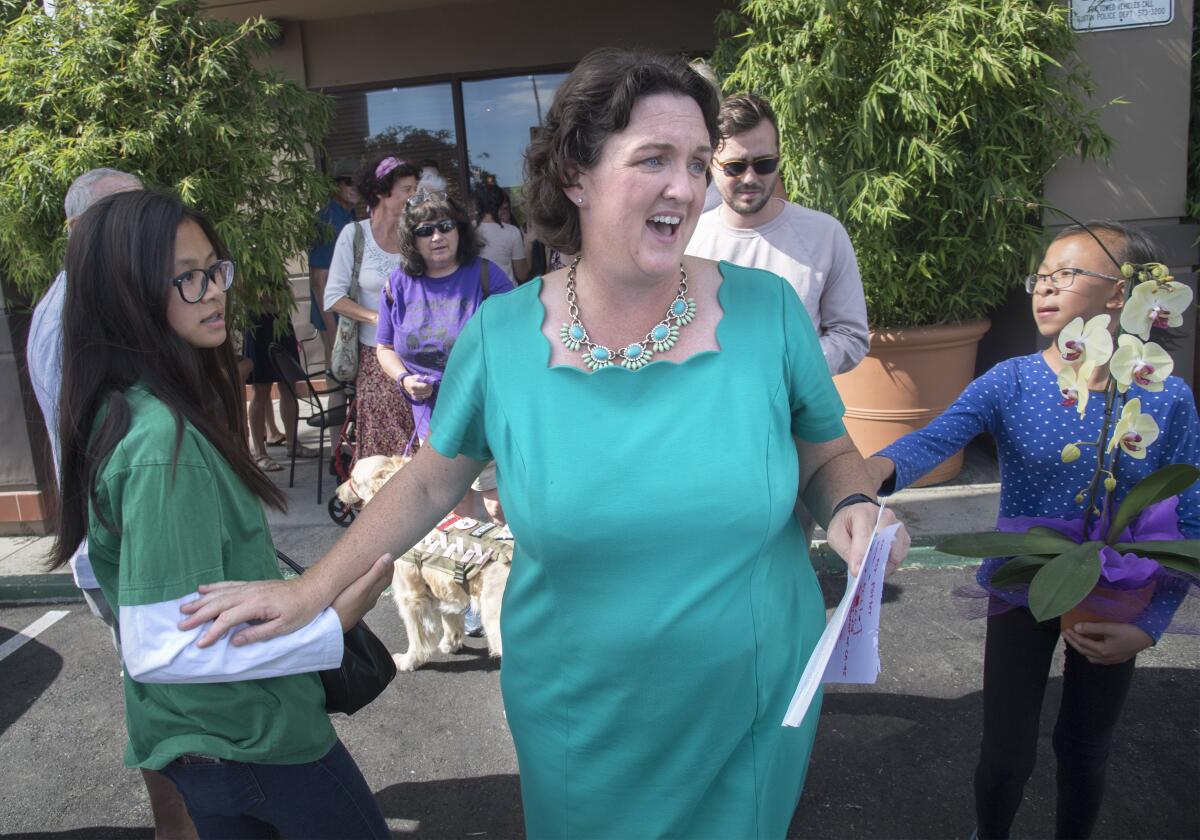
Democratic Rep. Katie Porter of Irvine, who unseated Republican Rep. Mimi Walters in the 2018 election, was celebratory about the voter registration news, but said Democrats should not grow complacent.
“We owe this to the local college student who knocked on doors, the single mom who phone-banked, and the retired senior who volunteered to register voters; because of all of their hard work we now have more voices from all backgrounds included in our democratic process than ever before,” Porter said.
“We welcome this news as we continue to build on the progress of last year,” she said. “We must keep the pressure up as we fight to solidify these gains in 2020 and keep Orange County blue.”
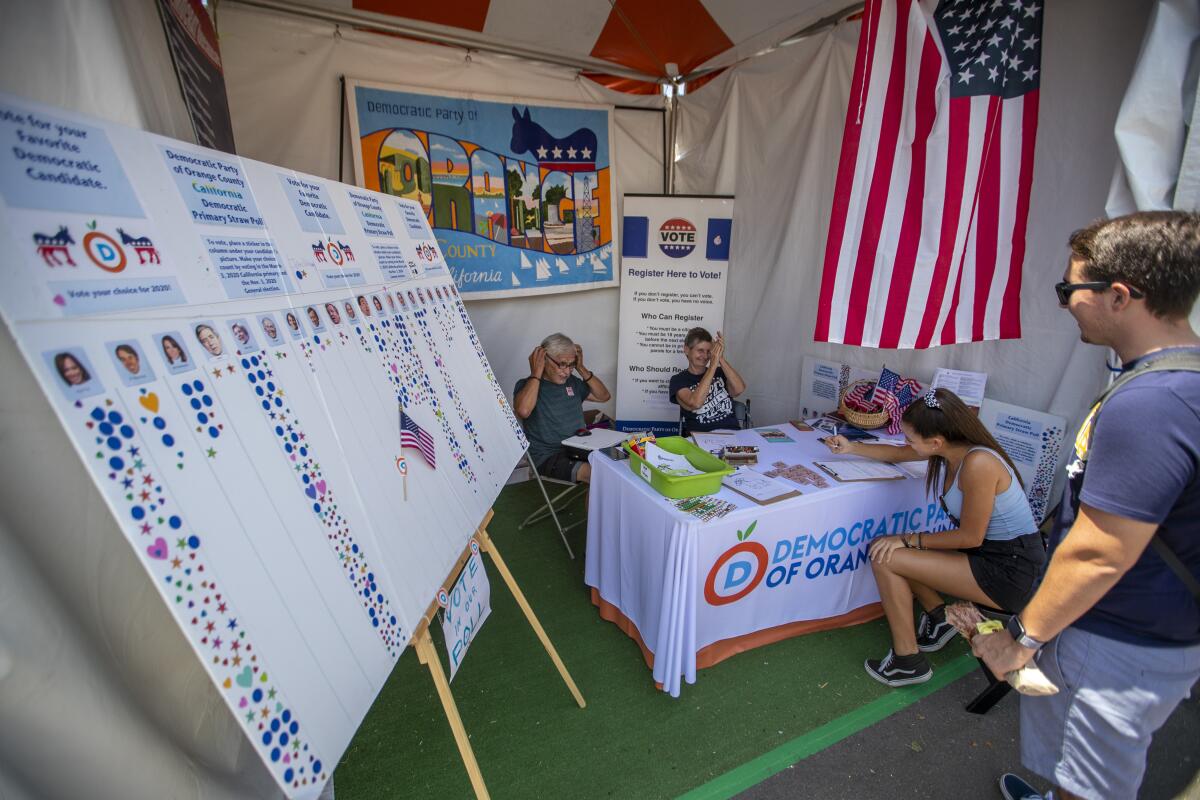
More to Read
Get the L.A. Times Politics newsletter
Deeply reported insights into legislation, politics and policy from Sacramento, Washington and beyond. In your inbox twice per week.
You may occasionally receive promotional content from the Los Angeles Times.
